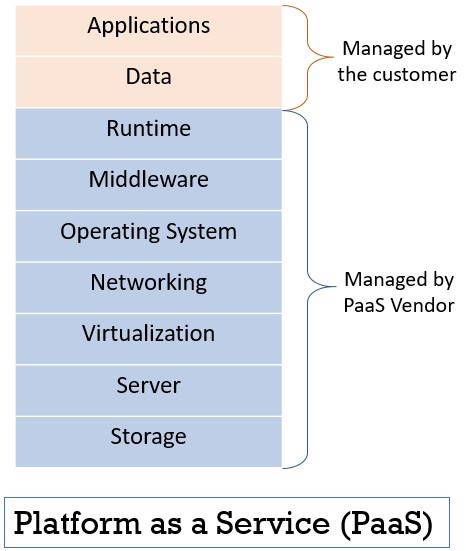Platform as a service (PaaS) is a cloud service where the cloud vendor provides hardware and software that forms the platforms on his self-owned infrastructure to the customer. The PaaS vendor offers this service to its customer on the consumption-based pricing model. Using the platform provided by the PaaS vendors the customer can develop and deploy their own software and apps.
As the entire platform is hosted by the PaaS vendor the customer does not have to worry about the maintenance and update of the platform, it is the responsibility of PaaS provider. Let us discuss platform as a service PaaS in brief along with its feature characteristics, benefits, issues associated with this service and examples.
Content: Platform as a Service (PaaS)
- What is Platform as a Service?
- Features of PaaS
- Benefits of PaaS
- Disadvantages of PaaS
- Key Takeaways
What is Platform as a Service?
In platform as a service (PaaS) is one of the three basic cloud services IaaS, PaaS and SaaS. In PaaS, the customer can purchase a run time environment that supports the development and deployment of any software or application. The PaaS vendor customizes the platform for the customer according to their requirement.
Prior to the advent of the cloud services, the developers have to indulge in the diligence of purchasing and setup of the hardware and software to form a platform required to support the complete life cycle of the developing and deploying the software or applications. The customers have to spend time and money to establish the platform they require. Purchasing PaaS saves the time and cost of the customer and lets customer focus on their major goal.
The customer can access his leased platform over the internet from any geographical location in the world. This eases the developer to build and deploy the software and applications to the users globally.

Unlike IaaS, in PaaS, the customer does not have a choice over the choosing of the operating system and middleware. PaaS services host storage, server, networking, virtualization, operating system, runtime environment, middleware to their customer over the internet. The customer has to only develop, run and manage their own apps on the provided platform.
Features of PaaS
PaaS vendor provides the following self-owned features in PaaS services.
- The key feature of PaaS service is that provide the customize platform to the customers where they can develop, test and deploy the software and app.
- The PaaS vendors host multitenant architecture which supports the use of the application by several users concurrently.
- PaaS vendor also offers web-based UI development tools that allow developers to create user interfaces.
- PaaS services offer integrated web services and databases.
- PaaS offers the tools that can be used by developers to analyses their data and view the greater insight into their developing application which help them in predicting the outcome. This helps in improving the designing of the application.
- PaaS also allow the developer to share the code with the predefined or distributed teams that enhance productivity.
- PaaS offering also includes concurrency management that supports concurrent operation simultaneously, scalability and security.
- PaaS services can be modified according to the requirement of the customer.
- PaaS also offers pre-coded application components to developers which saves time of the developers.
Benefits of PaaS
The cloud services are always beneficial following are the benefit of outsourcing platform as a service.
1. Cost and Time Saving: The traditional on-premises model has always been expensive and offers less guaranty of success. Opting for PaaS services saves your cost and time and also provides you with the customized platform for developing, testing and deploying the software.
2. Automated Updation and Maintenance: The customers do not have to worry about the upgrades as it is the sole responsibility of the PaaS vendor to upgrade PaaS services on regular basis.
3.Pay-as-you-go: The customer has to pay only for the services he is consuming. PaaS vendor does not bind you with the fixed services packages so the customer can select the required services and pay accordingly.
4. Customization of Services: The customer is free to choose among the wide range of features offered by the PaaS services. Thereby customer can customize the PaaS services according to their requirement.
5. 24/7 Assistance: The PaaS vendors have a team of experts that can support the complete PaaS infrastructure along with the applications. The assisting team provide 24/7/365 assistance to their customers.
Disadvantages of PaaS
Though PaaS services come with enormous benefits, there are always some issues with cloud services.
1. Security: Security is always an issue in cloud computing. There can be a risk over the privacy of data. To ensure more security the customer can always opt for private or hybrid cloud.
2. Internet dependency: The customer can access the PaaS services only if he has an internet connection. Without an internet connection, it is impossible for customers to access their leased services.
3. Lack of Portability: As the application is built using the vendor’s tools and his hosted platform, it will be difficult to switch an application to some other vendor’s platform. As the other vendor’s platform may not support the libraries, language, API or the operating systems. This leaves you in vendor lock-in condition.
Key Takeaways
- Platform as a service PaaS offers the runtime environment to develop, test and deploy the software or app.
- PaaS vendor bills the customer monthly like any other utility company bills their customer.
- The PaaS customer can access the platform provided by the PaaS vendor over the internet.
- PaaS vendor updates and manages the PaaS services and the customer can focus on their major goal.
So, this how using PaaS services developers can develop powerful software. The entire platform required to develop and deploy the software is hosted and maintained by the PaaS vendor.

Leave a Reply